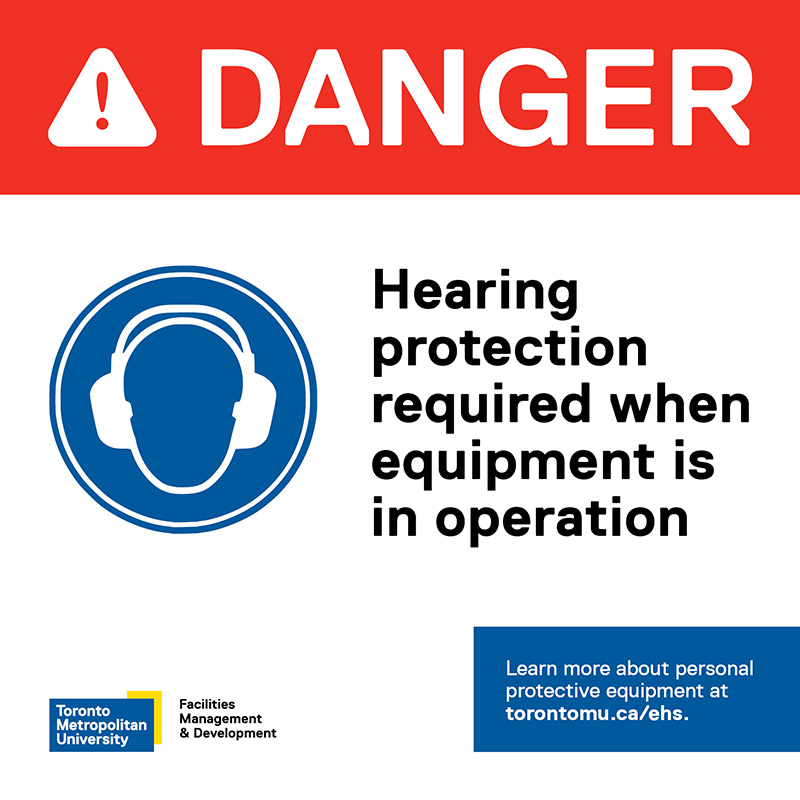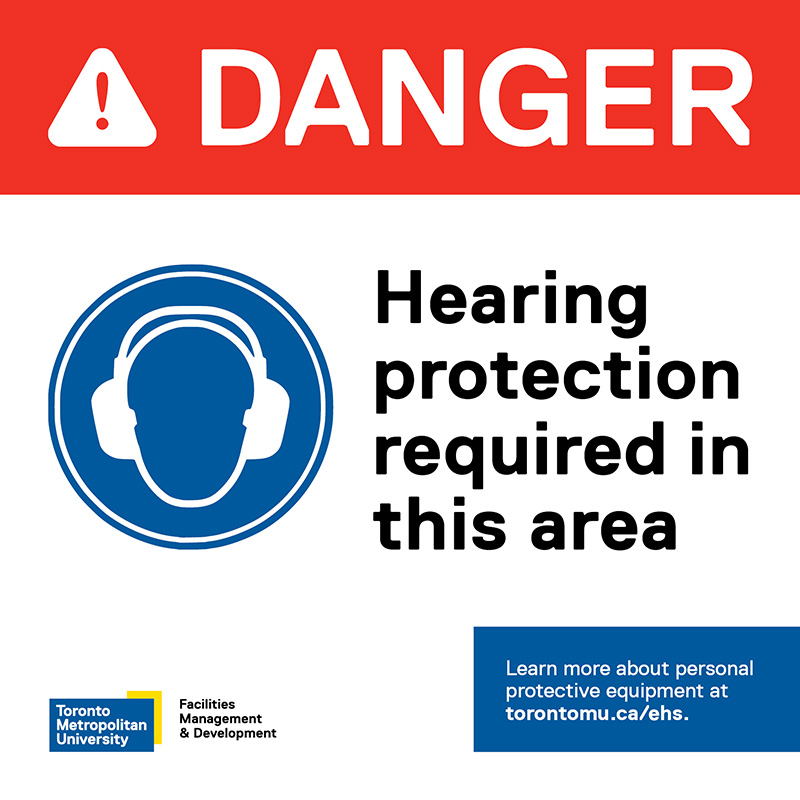Noise & Hearing Conservation
We are continuously surrounded by various sounds in our environment. The detection of sounds by human ear can vary from person to person. Depending on the circumstances, sounds can be perceived as being pleasurable or a nuisance.
What is noise?
Noise is a term used to describe unwanted sounds. It can be continuous, impulsive or intermittent over time. Noise can become a significant issue when the levels are high enough to cause permanent hearing loss or psychological stress that interferes with a workers productivity and communication, and can ultimately contribute to workplace incidents and injuries.
Key resource
An overview of the (google doc) Noise and Hearing Conservation Program (external link) , available to TMU students, faculty and staff, provides more detailed information to students, faculty and staff on roles and responsibilities, as well as program elements and applicable guidelines on the management of noise hazards at TMU.
Legislation
Under the Occupational Health and Safety Act, Noise Regulation (O. Reg. 381/15), every employer is responsible for ensuring that no worker is exposed to a sound level greater than a time-weighted average exposure limit of 85 A-weighted decibels (dBA) over an 8-hour work day. Regular exposure to sound levels greater than a time-weighted average of 85 dBA or an equivalent is associated with the development of noise-induced hearing loss.
At TMU, an area is considered a noise hazard area if the sound levels are regularly at or above 80 dBA. A worker is considered noise-exposed if noise dosimetry results exceeds the TMU Occupational Exposure Limit (OEL) of 80 dBA as a result of their work activities.
How is noise assessed?
Noise monitoring is conducted by Environmental Health and Safety (EHS) at TMU in consultation with departments to determine the presence of noise sources in their areas. Noise measurements are completed using a Type 2 Integrating Sound Level Meter or Type 2 Personal Noise Dosimeter set to the A-weighted scale (dBA). This scale is used to integrate all sound levels into one measured reading and is the best representation of what is experienced and perceived by the human ear.
In general, a noise hazard area is one in which someone is required to raise their voice to speak to another person who is at least one metre (3 feet) away from them. The table below provides examples of different sounds levels, some of which will not lead to noise induced hearing loss but still be unwanted or disruptive.
Decibel scale

Examples of different sound levels
Faint Level
- 10 dB - Breathing
- 20 dB - Rustling leaves
- 30 dB - Whispering
- 40 dB - Refrigerator
- 50 dB - Moderate rainfall
Moderate Level
- 60 dB - Conversation
Loud Level
- 70 dB - Car
Very loud Level
- 80 dB - Truck
- 90 dB - Hairdryer
Extremely loud Level
- 100 dB - Helicopter
- 110 dB - Trombone
- 120 dB - Police siren
- 130 dB - Jet engine
- 140 dB - Fireworks
All monitoring results for noise hazard areas are tracked and available through the (google sheet) Noise Hazards Area Tracking spreadsheet (external link) . Copies of noise-exposed monitoring results will be sent directly to the department supervisor and worker as well as their respective JHSC member.
How is noise controlled?
When appropriate exposure limits are exceeded, employers are required to put in place protective measures to proactively reduce workers exposure to noise. Ideally, these measures include engineering controls to reduce noise levels at the source or along the path of the worker and to ensure equipment is designed and maintained properly. However, when not deemed reasonable or practical to implement, administrative controls as well as personal protective equipment must be implemented.
Signage
Where it is practicable to do so, employers must post a clearly visible warning sign at every approach to an area in the workplace where the sound level regularly exceeds the regulatory limit. At TMU, signage is posted in noise hazard areas that regularly exceed 80 dBA.
Examples of TMU signage include:

Template #1
Template #1 can be utilized when hearing protection is required when equipment is in operation.

Template #2
Template #2 can be utilized when hearing protection is required in the area overall, regardless of whether or not there is equipment in operation.
If you are a supervisor who requires signage for you area, please contact EHS for additional support at 416-979-5000, ext. 553770 or ehs@torontomu.ca
Hearing Protection Devices (HPD)
Personal protective equipment in the form of hearing protective devices must be used when sound levels regularly exceed 80 dBA and/or when a job task exceeds the TMU Occupational Exposure Limit (OEL) of 80 dBA over an 8 hour work day.
These guidelines are in accordance with the CSA Standard Z94.2-14 Hearing protection devices: Performance, selection, care and use, which dictates the appropriate hearing protectors required for personal protective equipment. Further selection is based on a number of factors, including:
- the estimated or measured 8-hour noise exposure (i.e. Lex,8);
- the type of hearing protector;
- the noise reduction rating of the protector; and
- the duration of use.
Supervisors are responsible for the selection and provision of hearing protection in their area in consultation with EHS. They are also responsible for ensuring the equipment is worn by workers. For additional assistance, please contact EHS at 416-979-5000, ext. 553770 or ehs@torontomu.ca.
Training
Awareness training is provided by EHS and available to all employees who are exposed to noise and required to wear hearing protection. This training covers:
- the definition of noise;
- types of noise sources;
- the hazards of excessive noise (acute and chronic);
- noise assessment methods and results;
- noise control methods including noise signage used at TMU;
- areas and situations with risk of excessive noise, and areas where hearing protection is required at TMU;
- types of hearing protection available at TMU; and
- how to properly wear and maintain hearing protection devices.
Individual departments are responsible for providing training to employees on work-site specific control measures used to reduce noise and tracking this training (i.e. attendance sheets).
Where hearing protection devices are provided, department-specific training must include:
- use, care and limitations;
- importance of proper fit;
- inspection and maintenance; and
- cleaning and disinfection (if required).
For additional information, please refer to section 13 of the EHS (google doc) Personal Protective Equipment Manual (PPE) (external link) manual.
Contact us to schedule training
To schedule an awareness training session for employees working in noise hazard areas, please contact contact EHS at 416-979-5000, ext. 553770 or ehs@torontomu.ca.